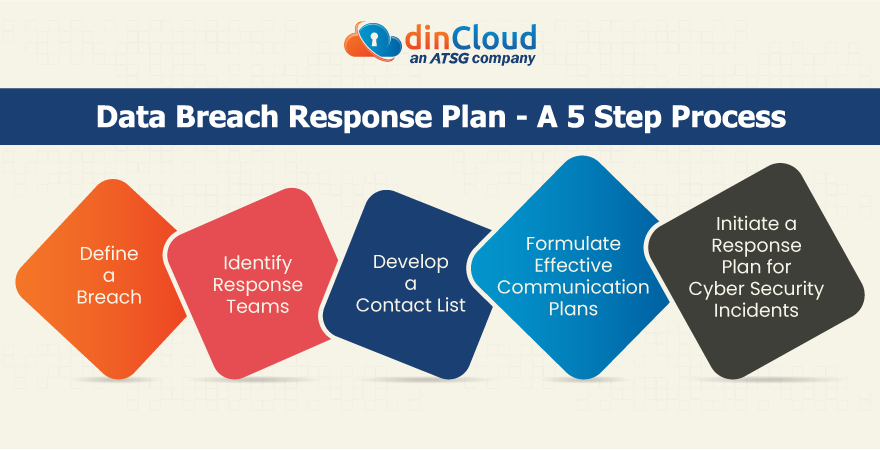In the world where bad actors are more equipped than ever to menace the IT infrastructures of businesses, it is a no-brainer that enterprises should immediately develop robust cybersecurity plans. This entails not only the protection of digital assets, but also evolving a precautionary response plan against an imminent data breach.
Data breach response plan seems like a pretty obvious choice to make; however, the reality seems to be quite different. A lot of market research and analysis can back the fact that even today, numerous enterprises do not have an effective data breach response plan in place. This itself, is courting disaster.

What is a Data Breach Response Plan and Why is it Important?
Today, cyber miscreants have access to such tools and technologies that can circumvent even the most effective layers of cybersecurity defenses. Enterprises should now go from defense to offense. An effective data breach response plan not only minimizes the adverse impact of data breaches, but also improves enterprise’s future resilience.
In simple terms, a data breach response plan is the framework that is utilized by an enterprise to respond to a cybersecurity incident. It documents what exactly can be regarded as a cybersecurity incident, bad actors involved in such plans, and the required follow-up actions.
It is important that enterprises show their key stakeholders and regulators that they are capable of resiliently bouncing back from data breaches, without severe and irreversible damages to their business. Panic and disorder will only “add fuel to the fire”, and erode customer’s future trust as well.
Data Breach Response Plan – A 5 Step Process
By implementing the following five steps, enterprises can develop a robust data breach response plan.

1. Define a Breach
The first thing that enterprises should do, even before writing down a response plan, is to identify what exactly constitutes as a breach. This involves identifying all the possible scenarios, from bad to worse. Some examples include Distributed Denial of Service (DDoS) Attacks, phishing scams, ransomware attacks etc., that can menace your IT environments. Risk assessment programs and security policies are used to categorize a breach.
These pre-planning exercises should also involve everything that can possibly be targeted by bad actors. It could be people, data, applications or entire systems.
All this is done as a precautionary measure to identify and contain cybersecurity breaches.
Related Posts:
- Benefits of Sophos Intercept X for dinCloud Endpoints and Servers
- Tightening Access Security Should Be a Priority
- Security Benefits of Cloud Computing Solutions
- How Do Industry Experts Visualize Cyber Security?
2. Identify Response Teams
Enterprises should identify people in their data breach response team, and clearly define their roles, along with a contact list of the response team. This list usually entails Top Executives, key IT representatives, Human Resource personnel, as well as Legal experts.
In case of a cybersecurity incident, or even a suspicion, employees will have clear-cut knowledge about who they should contact, instead of panicking and inflicting further damage.
3. Develop a Contact List
Another contact list should be created to determine people, outside the enterprise, who should be contacted, in case of a cyber security risk or emergency. This could include the contact information of regulatory authorities, along with third-party companies, like legal counsels, the insurance company, Cloud Service Providers (CSPs) and cybersecurity experts.
4. Formulate Effective Communication Plans
It is always advisable to prepare various pre-written statements or templates for your customers, staff and media houses. These statements should be written in such a way that they are adaptable, and can provide a thorough picture to all the related stakeholders, in accordance with the impact of the breach.
Another important factor is to ascertain a suitable time for disclosing any cyber security incident. You should never reveal any information about the cyber security incident to the public, unless you have a fair amount of clarity about what actually has transpired.
5. Initiate a Response Plan for Cyber Security Incidents
When a cybersecurity incident fulfills the criteria laid down in step one; that is the time to initiate the following mentioned incident responses.
- Have an all-inclusive record of every activity
- Perform actions to mitigate the impact of the incident
- Activate the processes defined for data loss and recovery
- Timely inform all key stakeholders and regulatory authorities
- Proceed with data security procedures, such as mandating password change, even after the breach has been contained
- Objectively determine the cause of breach
- Eradicate the identified vulnerabilities, to prevent subsequent breaches
- Initiate a follow-up plan to console, and re-assure the Customers impacted by the breach
- Monitor your incident response and work towards its improvement, if required
Other Vital Steps to Consider for a Data Breach Response Plan
Selection of the right Cloud Computing model, Cloud Service Provider (CSP), or a combination thereof is a huge task in itself. Hasty cloud deployments, and any resultant downtime, far outweigh the costs incurred to make well-informed decisions about preventing such incidents in the first place.
It will also be a good idea to incorporate expert advice in this regard, and also wisely select your Cloud Service Providers (CSPs). dinCloud is one such CSP, that offers free back-ups / snapshots of all its Cloud Hosted Virtual Desktops (dinHVD), for up to 10 whole days.
dinCloud, an ATSG company, offers built-in data encryption and data protection, across the entire cloud environment. This enables the full restoration of any virtual machine or file stored within our data centers, for the past 10 days, in the odd chance of a breach.
Conclusion
Any cybersecurity breach is a nightmare that no enterprise, regardless of its size, wants to experience. Recovery is not merely about data restoration or re-commencing work; the brand name and business reputation are equally important as well.
Panicked and un-professional responses to cyber security incidents can have a devastating impact on enterprises, in the form of customer churn and even decreased share prices. It is vital for organizations to come up with a data breach response plan, in case of a major attack or breach. These plans will resiliently navigate your enterprise through tough times, and put it back on track towards progress as well as innovation.
Feel free to contact dinCloud, an ATSG company, to avail a wide array of Cloud Computing solutions with built-in and customizable data back-up plans.


